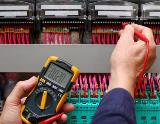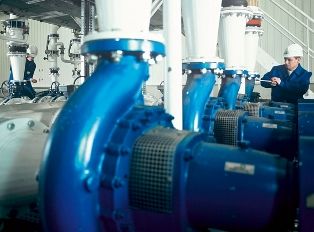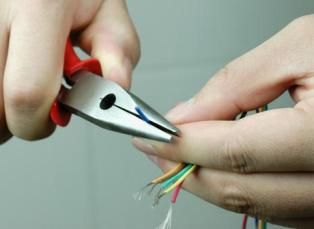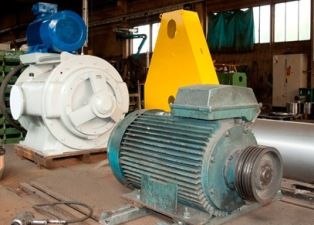Planned prevention of electrical equipment
 Preventive maintenance is the easiest and most reliable way to plan repairs.
Preventive maintenance is the easiest and most reliable way to plan repairs.
The main conditions that ensure a planned preventive connection in terms of equipment repair are the following:
• The main need for electrical equipment for repair is satisfied due to regular repairs carried out after a certain number of working hours, which is why a periodically repeating cycle is formed;
• Each planned preventive repair of electrical installations is carried out to the extent necessary to eliminate all existing defects, as well as to ensure the normal operation of the equipment until the next planned repair. The period of regular repairs is determined according to the established periods;
• The organization of planned prevention and control is based on the usual scope of work, the implementation of which ensures the effective condition of the equipment;
• The normal volume of work is determined by the established optimal periods between regular periodical repairs;
• Between scheduled periods, electrical equipment undergoes regular checks and inspections, which are a means of prevention.
The frequency and alternation of regular equipment repair depends on the purpose of the equipment, its design and repair characteristics, dimensions and operating conditions. Preparation for planned repair is based on the clarification of defects, the selection of spare parts and spare parts that will need to be replaced during the repair. An algorithm was specially created to carry out this repair, which ensures continuous operation during the repair. Such an approach to preparation makes it possible to carry out a complete repair of equipment without disrupting the usual work of production.

Preventative well-designed repairs provide for:
• Planning;
• Preparation of electrical equipment for scheduled repairs;
• Carrying out regular repairs;
• Carrying out activities related to planned maintenance and repair.
The equipment preventive maintenance system includes several stages:
1. Stage between repairs
It is carried out without disturbing the operation of the equipment. Includes: system cleaning; systematic lubrication; systematic review; systematic regulation of the operation of electrical equipment; replacement of parts that have a short service life; minor troubleshooting.
In other words, it is preventive maintenance that includes daily inspection and maintenance, while it must be properly organized to maximize the life of the equipment, maintain high-quality work and reduce the cost of regular repairs.
The main work performed at the overhaul stage:
• Tracking the condition of the equipment;
• Implementation by employees of the rules for appropriate use;
• Daily cleaning and lubrication;
• Timely removal of minor damages and corrections of the mechanisms.

2. Current stage
Preventive maintenance of electrical equipment is most often carried out without disassembling the equipment, only its operation stops. It includes the elimination of damage that occurred during the period of operation. At the current stage, measurements and tests are carried out, with the help of which the shortcomings of the equipment are identified at an early stage.
The decision on the suitability of the electrical equipment is made by the workshops. This decision is based on a comparison of test results during routine maintenance. In addition to regular repairs, to eliminate equipment defects, work is carried out outside the schedule. They are carried out after the entire resource of the equipment is exhausted.
3. Stage in the middle
It is carried out for full or partial restoration of old equipment. Includes disassembly of units intended for inspection, cleaning of mechanisms and elimination of identified defects, replacement of some rapidly wearing parts. The middle stage is carried out no more than once a year.
The system in the middle stage of planned preventive maintenance of the equipment includes installation of the cycle, volume and sequence of work in accordance with the normative and technical documentation. The middle stage affects the maintenance of equipment in good condition.
4. Overhaul
It is carried out by opening the electrical equipment, its complete inspection in view of all parts.It includes tests, measurements, elimination of established malfunctions, as a result of which modernization of electrical equipment is carried out. As a result of the overhaul, the technical parameters of the devices have been completely restored.
Major repair is possible only after the major repair stage. To do it, you need to do the following:
• Preparation of work schedules;
• Do a pre-screening and inspection;
• Prepare documents;
• Prepare tools and necessary spare parts;
• Take fire precautions.
The overhaul includes:
• Replacement or restoration of worn mechanisms;
• Modernization of any mechanisms;
• Performing preventive checks and measurements;
• Carrying out work related to the removal of minor damages.
Malfunctions found during the inspection of the equipment are eliminated during subsequent repairs. And accidents of an emergency nature are eliminated immediately.
Each individual type of equipment has its own frequency of planned preventive maintenance, which is regulated by the Technical Operation Rules. All activities are reflected in the documentation, strict records are kept of the availability of equipment, as well as its condition. According to the approved annual plan, a nomenclature plan is created, which reflects the implementation of major and current repairs. Before starting current or major repairs, it is necessary to clarify the date of installation of electrical equipment for repair.
Schedule of the year of preventive maintenance — this is the basis for preparing a budget plan for the year, developed 2 times a year.The amount of the year of the evaluation plan is divided into months and quarters, it all depends on the period of overhaul.
Today, computer and microprocessor technology (structures, stands, installations for diagnostics and tests) is most often used for the system of planned equipment prevention, which affects the prevention of equipment wear, lower repair costs and also contributes to an increase in work efficiency.

